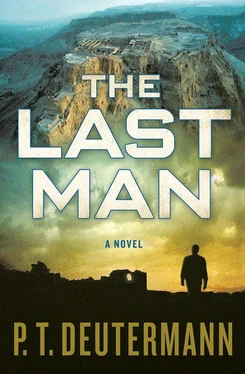Okay, that computes, he decided. Now, if that’s where the water would go, and I’m right about all this, there should be another cistern, something a hell of a lot bigger than that pool, somewhere under this slope. It can’t be too close to the gate, or the Yadin expedition would have found it. They had found and mapped all of the rim cisterns that pitted the eastern and southern wall of the mountain. What had attracted Adrian’s attention a long time ago when she had begun studying the mystery of Masada was that none of the rim cisterns would have tapped the biggest catchment area of the mountaintop. There had been speculation that the top of the mountain had been under cultivation in Herod’s time, but David did not accept that this had been farming in the traditional sense. Ornamental gardens and parks in the palace precincts, yes, but even two thousand years ago, there would have been no real topsoil up here on this barren wedge of rock. He knew that an inch of rain on a flat acre accumulated twenty-seven thousand gallons of water. So five, maybe even six acres of rocky slope would have produced a fairly decent runoff of water down there by that gate. He had seen no signs of drainage holes or channels when he approached the eastern gate from the Serpent Path, and he had been looking. More than ever, he was certain that they had not wasted that bounteous runoff. Adrian had been convinced that there had to be one more cistern, probably a natural cave system of some kind. Time to find out.
He scooped up the ball, went back over to the backpack to extract the survey equipment, and then checked his watch. Twenty until two. He smiled as he began laying out the equipment, remembering the salesman’s curiosity as to why a nuclear engineer would want to buy a geologist’s seismic survey pack. He had told the man that he owned property up in the Shenandoah Valley and wanted to search one of his fields for caves. The salesman had recommended a refraction survey set, which consisted of a small explosive sound source, four geophones, a data collection unit, and a software package that would draw a vertical profile of the area under the geophone array from the data collected. Since he was doing a vertical survey, he placed the seismic source as close to the middle of the open area as he could figure, then placed the four geophones in a rough square around the source at a radius distance of about one hundred and fifty feet. Before placing the source, he scuffed the ground to expose bare rock and then found a large stone building block from one of the casemate wall sections to put on top of the source disk. Once he had the source positioned, he used his hat to gather sand from around the area to bury the source charge in order to deaden the sound.
Returning to his backpack, he extracted a small coil of wire and made connections to the terminals on the side of the source disk. He stretched the wire out to its full extent, about sixty feet, and left it there while he went around to the four geophones and took the tape off their battery connections. He repeated the precaution of clearing away any sand or loose soil to ensure that the geophones were in contact with bare rock, raised their tiny stub antennas, and then placed a small stone on top of each one to maintain firm ground contact.
Working quickly now, he set up his portable computer, using the backpack as a cushion, and then ran a cable between the computer and the data collection device, which he perched on a rock so that it was in clear line of sight of all four geophones.
He stood up and surveyed the layout. Geophones equally spaced around the source, the seismic source tamped with a good-sized rock, the data collection block in position to receive the signals from the geophones, the computer on and hooked up to the data collection block. Good. He took the spare battery for the computer over to where the end of the wire lay in the dirt and put it down. Then he walked around the geophone pattern and energized each one, getting a tiny green LED light in response showing readiness to record and transmit. He walked back to the data collection block and turned it on, checking to see that it was receiving a carrier wave on its first four channels.
All right. He went back to the computer and brought up the data display program, which on-screen looked like nothing more than a piece of graph paper, with X and Y axes. Ready.
He looked at his watch again. Two ten. Still feeling a nagging sense of concern about that army patrol, he walked all the way back over to the western wall gate, stepped down through the casemate stairs, and peered out over the siege ramp. He could see both ends of the deep ravine, but there were no signs of activity down there in the shadows. He wondered how many slave skeletons were buried under that ramp. The rubbled walls of the Roman camp were etched in gray spidery lines on the plateau opposite, adamantly foursquare after two thousand years.
He walked quickly back up the stone steps and across the open space to his computer. Checking one more time that the device was ready to receive data, he went over to the end of the wire. He hooked up one conductor to the negative terminal of the battery, and then, pausing to take a deep breath, he touched the other conductor to the positive terminal. There was a flash of dull red under the big stone as the sand was blown out, and simultaneously a thump. He was glad he had piled the sand on top of the source charge: Otherwise that noise would have carried for miles in the still desert air. The rock had not moved, though, which meant that the bulk of the energy had gone down into the rock.
He disconnected the wires, slipped the battery into the backpack, and walked back down to the source, rolling up the wire as he went. He picked up the large stone, scuffed out the black smear under it, picked up the scorched disk, and carried the stone back over to where he had found it. Then he went around and picked up each of the geophones, turning each one off and ejecting its batteries into the backpack. Finally he returned to the computer, kneeling down on the hard ground to examine the screen. He punched a few keys, confirmed that data was available, and then, again holding his breath, hit the DISPLAY command. His heart sank when the NO DATA message appeared on the screen.
There had to be data. He hit the HELP key, which dropped a box of instructions. Do it again, he told himself. Slow down on the keyboard. Be precise. Then his heart started to pound when he saw the dancing cursor, beginning at the top of the virtual page, begin to scrawl fine, densely packed horizontal lines across the screen.
One line.
Five lines.
Seven lines. Straight as a die, indicating solid rock.
C’mon, c’mon, he thought. Don’t tell me this has all been for nothing.
Then, on the eighth, a partial line, a space, and then a completion. He held his breath to see if it was simply a data anomaly. No — the ninth line, the cursor did the same thing, only the space in the middle of the line was infinitesimally bigger. As was the tenth.
He felt a rush of excitement as the display continued to show, line by line, a large, very large cavity in the rock below. She’d been right, by God!
No more theories: There it was, and it was big, as big as, if not bigger than, the northern wall cisterns. He stared down at the left-hand scale as the cursor descended down the screen, outlining a huge spherical cavity. When it had finally reached the bottom of the screen it was showing one hundred and eight feet vertical height on the cavity, with one end shallower, at about eighty feet. One edge of the cavity image was missing; he would have to figure out what that meant. There was no way of telling precisely how wide across it was, because the shot had provided only a single vertical acoustic profile. The geophones had a maximum separation of three hundred feet, so at least that wide. This damned thing wasn’t big: It was huge !
Читать дальше












